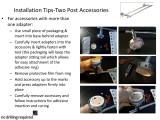
6809517A42-A January 10, 2008 11
Level 1 and 2 Service Manual Product Overview
Product Overview
MOTOROKR™ E8 telephones represent the thinnest, most compact and
lightweight global system for mobile communications (GSM) general packet radio
service (GPRS) wireless application protocol (WAP)-enabled mobile phones. The E8
phones incorporate an improved user interface for easier operation, allows
multimedia message service (MMS) messaging, and includes personal information
manager (PIM) functionality.
The E8 is a quad-band phone that allows roaming within the GSM 900 MHz, GSM
850 MHz, 1800 MHz digital cellular system (DCS), and 1900 MHz PCS bands.
E8 telephones support GPRS and Enhanced Data rates for GSM Evolution (EDGE)
in addition to traditional circuit switched transport technologies.
The E8 phone consists of the main housing assembly that contains the battery,
battery cover, accessory connector, main circuit board, chassis, keypad, and internal
antenna. The main display, speaker, control keys, and a morphing keypad are
located on the front of the device. The camera, battery compartment, and rf
connectors are located at the rear of the device. The standard 950 mAh Lithium Ion
(Li Ion) battery fits behind a removable back cover and provides up to 500 minutes
of talk time with up to 280 hours of standby time
1
. The display module consists of
240 x 320 pixel, Active Matrix Liquid Crystal Display (AMLCD) with white pixels
on a black background. The CLI screen is a 2.0” transflective sub display, and the
primary screen is a 2.2” transmissive main display.
The camera module is a 2.0 mega pixel VGA CMOS camera.
The main housing assembly includes a battery cover, chassis, main circuit board,
keypad plastic front housing, and internal antenna.
The main circuit board contains the Receiver, Transmitter, Synthesizer and Control
Logic Circuitry and phone electronics.
The telephones are made of polycarbonate plastic. The display and speaker, as well
as the 23-key keypad, transceiver printed-circuit board (PCB), microphone, charger
and headphone connectors, and power button are contained within the candy bar
form-factor housing.
The phone accepts both 3V and 1.8V mini subscriber identity module (SIM) cards
which fit into the SIM holder next to the battery. The antenna is mounted internally.
Direct connection to a computer or handheld device provided by USB or Bluetooth®
for data and fax calls, and for synchronizing phonebook entries with Mobile Phone
Tools software, can be accomplished by using the optional data cable and soft
modem.
Features
E8 telephones use advanced, self-contained, sealed, custom integrated circuits to
perform the complex functions required for GSM communication. Aside from the
space and weight advantage, microcircuits enhance basic reliability, simplify
maintenance, and provide a wide variety of operational functions.
Features available in this model include:
• Messaging: MMS, EMS 5.0, IM Wireless Village, Email (POP3, SMTP, IMAP4)
• Music: MIDI, MP3, AAC, AAC+, Enhanced AAC+, WMA, WAV, AMR-NB, Real
1. All talk and standby times are approximate and depend on network configuration, signal strength, and features selected.





















